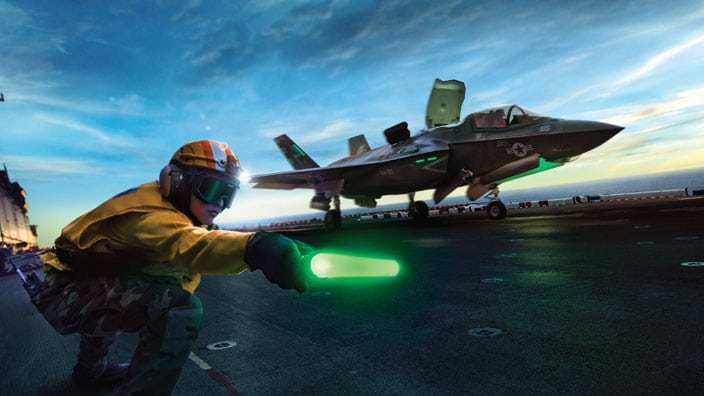[Lockheed Martin 10-21-2015] Current sales of Lockheed Martin’s F-35 have helped to lift profits in recent months, with the company’s aeronautics division seeing an 11 percent uptick in sales during the quarter when compared to the same period in 2014, posting $337 million in profits. According to Marilyn Hewson, Lockheed Martin chairman, president and CEO, the F-35 now represents 20 percent of annual corporate revenues, and the company is on track to achieve deliveries of approximately 45 aircraft in 2015, representing 25 percent higher aircraft deliveries than 2014.
 |
| Lockheed Martin F-35B. Photo: Lockheed Martin |
The previously troubled program has made strides lately with the U.S. Marine Corps.’ F-35B demonstrating Initial Operating Capability (IOC) in July, making it the first variant available for combat operations. “This figure is expected to grow over the next few years as production rates increase for deliveries to U.S. and international customers,” Hewson said during Lockheed Martin’s third quarter conference call on Tuesday.
The company posted steady numbers for in its 2015 third quarter report, registering sales of $11.5 billion for the quarter, a slight increase when compared to $11.1 billion during the same period of 2014. But the three-month Continuing Resolution (CR) set forth by Congress to carry funding through to Dec. 11 in lieu of an approved U.S. federal budget has capped 2015 spending at prior year levels and is limiting growth prospects in several areas for the government contractor, including the F-35.
“There are multiple and differing budget scenarios proposed by the White House and Congress for fiscal year 2016 budgets. Significant differences remain between the proposed budgets in the areas of funding sources and the potential use of increased overseas contingency operation funds for the [Department of Defense] DOD,” said Hewson, noting that reconciliation of the different DOD budget positions could prove elusive for some time.
Should the budget constraints dip into fiscal year 2016 and extend to a full year CR, Hewson says the company “would anticipate some level of impact against our 2016 orders profile and corresponding backlog levels.” Specifically, this could impact sales for 19 F-35’s incorporated in the Low-Rate Initial Production (LRIP) lot 9 contract that Lockheed Martin is currently negotiating with the DOD.
“You would start to see that pick up steam in 2017 and 2018 and beyond,” said Bruce Tanner, Lockheed Martin executive vice president and chief executive officer during the call. “Mind you, we do record revenue and earnings on a cost-to-cost basis as opposed to units of delivery, so those 19 aircraft would start having less growth than we had expected to have happen, but not much in 2016. It will start happening in 2017 and beyond.”
The F-35 is also seeing significant sales abroad and with Italy flying inaugural flights of its F-35 earlier this year, marking the first flight of the aircraft outside the U.S. The company expects to see a pick up in international F-35 sales, which may help hedge the impact from domestic budget constraints.
“There’s numerous F-35 international buys, all commingled within the LRIP 9 and LRIP 10 contracts that we’re negotiating there. But those do contain significant quantities of international customers,” said Tanner.
The company is hoping to grow business abroad with the fighter jet programs and is fairly confident it will close a series of deals in coming months.
“We expect to have both some modification — or at least one fairly good-sized modification program on F-16s; and we haven’t given up on selling new F-16s to at least a couple of different prospects. We’re hopeful we can get at least one of those deals closed in 2016. So that’s four — probably more than that if you include the multiple numerous customers within F-35 — but those are some of the larger ones next year,” said Tanner. Hewson noted that the company has not seen a significant slow down in sales from the Middle East as a result of dipping oil prices.
Lockheed Martin is also hoping to close its acquisition of Sikorsky helicopters from United Technologies Corp. (UTC) in 2015, although the deal recently took heavy criticism from the DOD. Frank Kendall, the undersecretary of defense for acquisition, technology and logistics, came out after the deal was announced against heavy consolidation of major companies, warning it could quash innovation and competition, upping prices. Despite the criticism, the deal is expected to close in the fourth quarter of 2015, although Hewson rejects Kendall’s claims.
“Bottom line, as you can hear from my passion in my voice, is we do not believe that consolidation will inhibit innovation in the industry,” Hewson stated during the call.